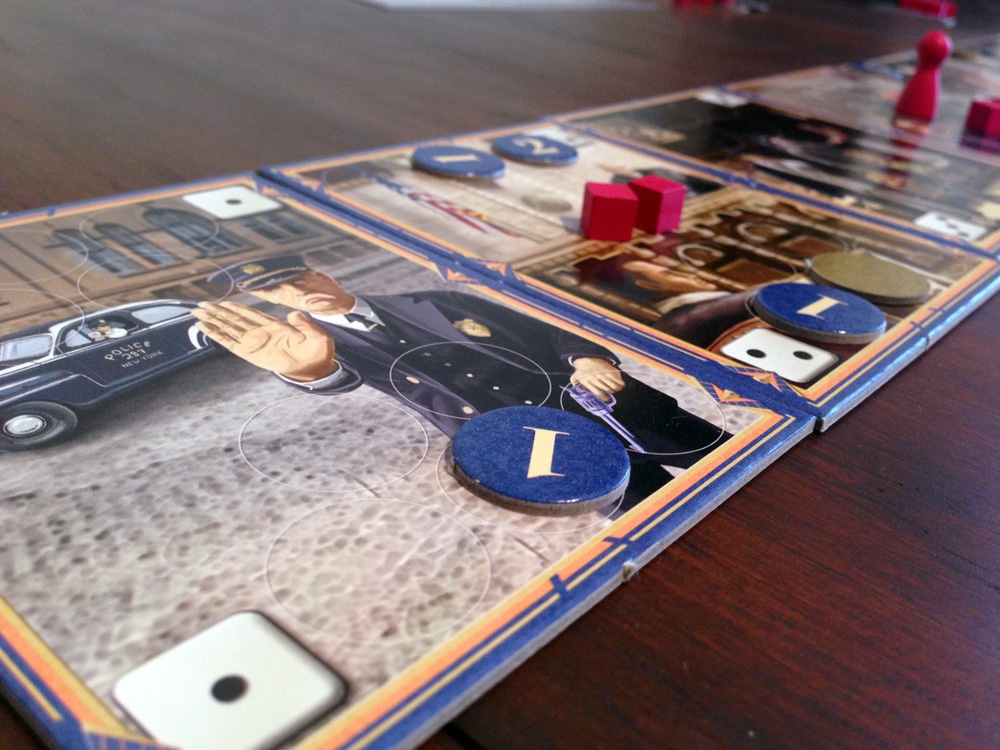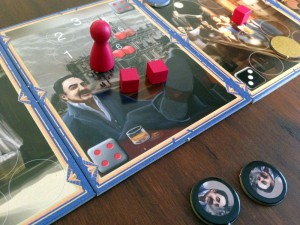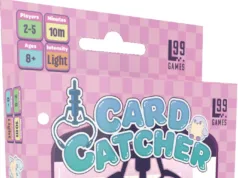 I have quite a few “push your luck” dice games in my gaming library. One of the main reasons for that is because my primary gaming partner seems to love them. Whenever we have a little bit of free time to kill, she’s always suggests we reach for one of these excellent filler games. It’s understandable why, they are easy to get to the table, play quickly, and refreshing on the rules usually only takes minutes.
I have quite a few “push your luck” dice games in my gaming library. One of the main reasons for that is because my primary gaming partner seems to love them. Whenever we have a little bit of free time to kill, she’s always suggests we reach for one of these excellent filler games. It’s understandable why, they are easy to get to the table, play quickly, and refreshing on the rules usually only takes minutes.
Today’s review of Capo dei Capi will take a look at the newest entry into the push-your-luck genre of games. In this two player only dice game, each player is taking on the role of a rival gang during the prohibition era in the United States. Does Capo dei Capi have enough to stand out in an already crowds genre of games? Read on to find out!
Capo Dei Capi is a push your luck dice game for two players that plays in about 20 minutes.
Game Overview:
Capo Dei Capi is a game about placing your influence on the games various areas all while trying to court lady luck. During the game, the players will take turns rolling the game’s two dice and strategically using their important mayor tokens. Each turn, players will be trying to place influence chips on each of the games 6 different tiles. However, if a player pushes his luck too far, he’ll lose all the progress he’s made that turn. Once one of the token piles runs out, the game is over and the player with the most influence in the city is the winner.
Game Components:

While Capo dei Capi comes in a fairly small box, it’s actually pretty packed with components. The game comes with 7 different tiles that function as the game board. These are illustrated with some great, thematic art that fits the game well. I really have to give kudos to Dr. Finns for making the board portable, functional, and thematic.
The game also comes with quite a number of tokens to use during the game. I spent a good amount of time punching these out and getting them sorted. Finally there are 2 standard pawns and a black die and a white die, which will be the focal point of the game.
All-in-all I think that gamers get a solid box of components in Capo die Capi and shouldn’t have any complaints, this is especially true considering the games low price point.
How to Play:
I’ll admit it; I didn’t have the easiest time wrapping my head around how to play the game. That isn’t to say that the rulebook is bad. It’s actually laid out nicely and includes both photos and game play examples. But for some reason I just wasn’t getting it and ended up watching the demo video on their kickstarter page. Afterwards, the game immediately clicked for me and I’d highly suggest checking out that video if you want to jump in quickly. I think it’s because the concept of the game is really different than just about any other “push your luck” dice game I’ve played before. Or it could be I was just having some kind of mental block and was being a dummy. I’ll let you decide.
With that being said, players start the game by laying out the game’s seven tiles in a single row. 6 of the tiles depict a numbered, 6-sided die ranging from 1-3 (three tiles show a black die, three show a white die). In the center between these 6 numbered tiles goes the mayor card. The tokens are then sorted into their various piles and the start player collects five mayor tokens while the second player takes six.

The first player takes their turn by rolling the black and white dice. They then compare the results of each die to the handy chart provided on the player aid (The player aid is a godsend in Capo dei Capi). I’ll give you a quick summary of the dice actions here, but check out the player aid in the image to the right to get a better understanding.
Based on the highest number rolled, different actions will be taken:
Highest number 1-3 (Influence): A player uses the two dice as a guide to place an influence token next to one of the tiles.
Highest number 4 (Extort): Move the extortion pawn on the mayor card and place a number of mayor chips next to that tile.
Highest number 5 (Bribe): Similar to the Influence action above, this time a face down bribe token is placed next to a tile.
Highest number is 6 (Invest): Place a value cube from the supply onto one of the tiles. This raises their victory point value.
If a player rolls doubles on a turn, they reference the special action chart instead. These will be similar to the above actions, but usually more powerful.
After a player has taken this action, they then must decide whether to press on and roll again or call it quits. If they stop, they take any chips they have next to the tiles and place them on the tile in the influence area. These are now points that they will use to try and win the tile at the end of the game. Any mayor chips are taken in hand by the player.
If a player decides to press on during they turn, they simply roll again and apply the indicated results. However, if one of the game’s three “bust conditions” happens, their turn ends and any tokens that were next to a tile are discard back to their respective supplies. The three ways to bust are:

1. Rolling double twice: After a player rolls doubles once, they take the hit man token as a reminder that if they roll doubles again, they bust out.
2. Inability to place a token: Each tile can only have 1 token next to it. So if a player has to place another token next to that tile, they bust out.
3. Maximum extortion limit exceeded: The mayor’s extortion track goes up to 6. If a player ever needs to raise it past that, they bust.
Finally, the mayor chips are where the strategic value of the game comes from. These can be cashed in during the game for a variety of effects like re-rolling dice, avoiding the hit man, and forcing a player to re-roll his action. Using your mayor chips wisely is vital to winning in Capo dei Capi.
Rounds will go back and forth in this matter until one of the game’s (except mayor chips) supply piles are empty. The game then immediately ends with the player finishing their turn as if they’ve called it quits. For each of the 6 tiles, each player totals up their total influence on that card. The player with the higher influence value scores that card (1pt) and any influence cubes on it (1pt each). The player with the most victory points is the winner.

Game Experience:
Even after more games of Capo Dei Capi than I can count, I still have to constantly reference the player aid when I roll the dice. This is both good and bad in my opinion. It speaks volumes to the games variety and replay value, but it also means the game is a little less intuitive then it could be. Both of these considered though, we still find Capo dei Capi to be a lot of fun. I think it’s actually near the top of one of my list of these types of dice games.
To be honest though, Capo Dei Capi isn’t really a hard game to play. The basics are roll the dice, look up the results, avoid busting, and spend mayor chips. That’s it. You really just need to know the bust requirements to get going. I think the rule book could have used quick play sections that basically amounts to that. But it only takes a turn or two to get a feel for the game and players should have no issues after that.
One of the reasons I really enjoy Capo Dei Capi is because it’s very different from a lot of the other push your luck dice games out there. The sheer volume of roll options you can get on your turn will constantly keep you on your toes and force you to stay flexible with your strategy. But those roles aside, the reasons Capo dei Capi works so well is because of the mayor chips. If it weren’t for those, this would be an average game, at best.

We quickly found out that the mayor chips are the life blood of the game. There are six different things a player can do with them and using the chips at the right time is critical in Capo Dei Capi. This is a way for the players to not only mitigate the luck factor in the game, but also to mess with their opponent. If you want to be really good at Capo Dei Capi, then strategically using your mayor chips are key. Just about every element in Capo dei Capi that is beholden to luck can, in some way, be altered with the use of the mayor chips. The easy choice is just saving them to avoid a bust, but a wise player will carefully examine the other ways to use them. For me, that’s what pushes Capo dei Capi from being “just another dice game” into a really good one.
Once you get a feel of how the game was played, Capo dei Capi goes by pretty quickly. You will have to quickly assess your risk tolerance because, at times, Capo dei Capi can be pretty unforgiving. I tend to spend my mayor chips quickly (and sometimes foolishly) and sometimes I pay the price because of it. But that’s ok. It seems like there are a lot of paths to victory in Capo dei Capi, a rarity in a filler game.
Finally, one of the fun things about Capo dei Capi is that it’s also an area control game. It seems like most press your luck dice games are just about quickly getting points. With Capo dei Capi, you have to carefully balance when to push your luck with trying to gain control of each of the six different areas. Thanks to the value cubes, the areas will fluctuate in how many points they are worth during the game, these force players to be flexible with their strategies.
Final Thoughts:
I actually don’t have a lot of complaints with Capo dei Capi. The game is well made, the rules really aren’t that complicated (as long as you have the included player aid to reference), and it plays quickly. Those are all positives for a filler game. There are a myriad of press your luck dice games on the market today and I think Capo dei Capi has carved itself out a nice niche of being on the more strategic side of that genre. As a 2 player only game, Capo dei Capi quickly became a game I could easily bring to the table and play with Mrs. Board Game Quest (It also helps that she really enjoys it and usually beats me). So if you mostly game with your spouse, this makes for an excellent choice.
We’ve reviewed a couple of Dr. Finns games here on Board Game Quest (Scripts & Scribes, Gunrunners) and Capo Dei Capi is easily my favorite of his games to date. The game is well made, the rules are clever and unique, and the game is very easy to get to the table. Grab a copy of Capo Dei Capi today, and try not to bust as much as I do.
If you are interested in getting a copy for yourself, it’s about $25
Final Score: 4 Stars – One of the better push your luck dice games out there. Dice rolling and area control in a quick playing game…what’s not to love?!
 Hits:
Hits:
• Unique game play for a push your luck dice game
• Great artwork
• Quick playing time
• Low price point
Misses:
• Not the most intuitive to learn





















